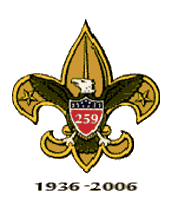CYCLING Merit Badge
- Show that you know first aid for injuries or illnesses that could occur
while cycling, including hypothermia, heat reactions, frostbite,
dehydration, insect stings, tick bites, snakebites, blisters, and
hyperventilation.
- Clean and adjust a bicycle. Prepare it for inspection using a bicycle
safety checklist. Be sure the bicycle meets local laws.
- Show your bicycle to your counselor for inspection. Point out the
adjustments or repairs you have made. Do the following:
- Show all points that need oiling regularly.
- Show points that should be checked regularly to make sure the bicycle
is safe to ride.
- Show how to adjust brakes, seat level and height, and steering tube.
- Describe how to brake safely with foot brakes and with hand brakes.
- Show how to repair a flat. Use an old bicycle tire.
- Take a road test with your counselor and demonstrate the following:
- Properly mount, pedal, and brake including emergency stops.
- On an urban street with light traffic, properly execute a left turn
from the center of the street; also demonstrate an alternate left turn
technique used during periods of heavy traffic.
- Properly execute a right turn.
- Demonstrate appropriate actions at a right-turn-only lane when you are
continuing straight.
- Show proper curbside and road-edge riding. Show how to safely ride
along a row of parked cars.
- Cross railroad tracks properly.
- Describe your state’s traffic laws for bicycles. Compare them with
motor-vehicle laws. Know the bicycle-safety guidelines.
- Avoiding main highways, take two rides of 10 miles each, two rides of 15
miles each, and two rides of 25 miles each. You must make a report of the
rides taken. List dates, routes traveled, and interesting things seen.
 | The bicycle must have all required safety features. It must be
registered as required by your local traffic laws. |
- After fulfilling requirement 8, lay out on a road map a 50-mile trip. Stay
away from main highways. Using your map, make this ride in eight hours.
.
|


